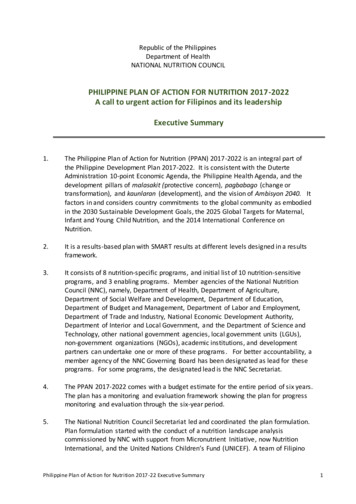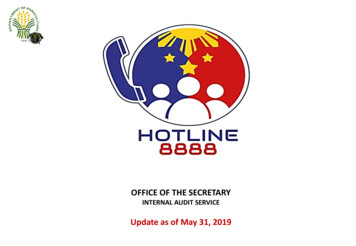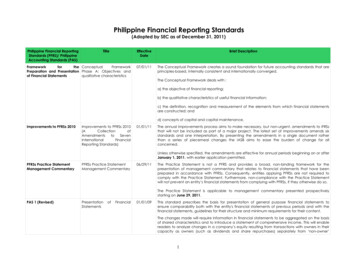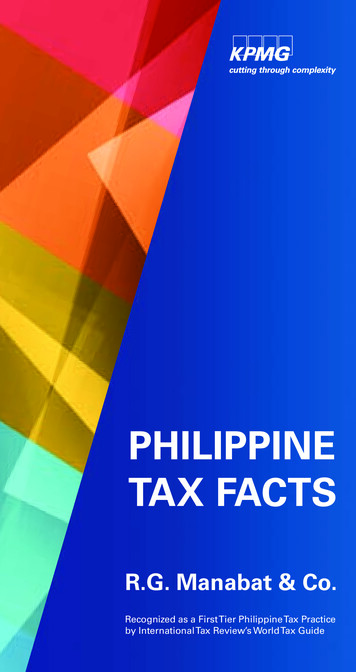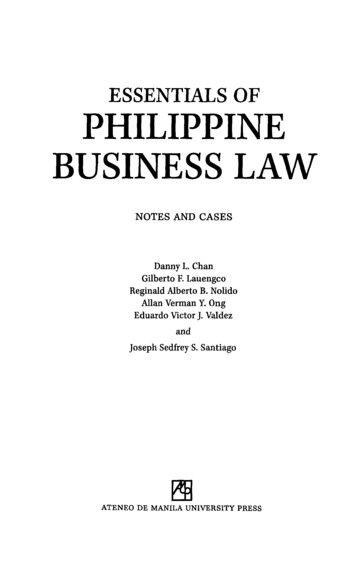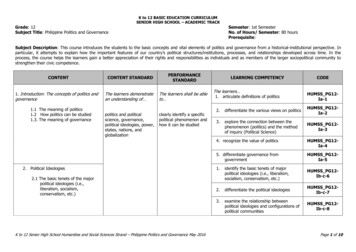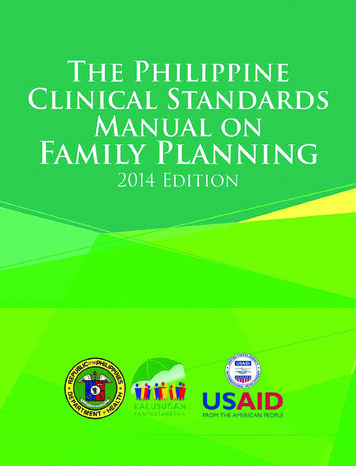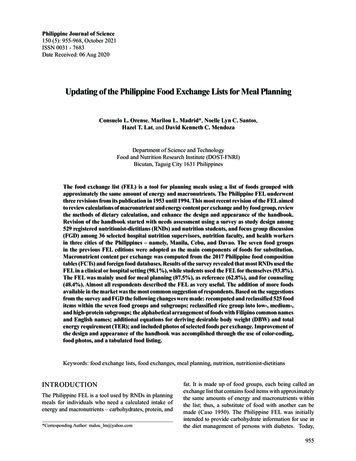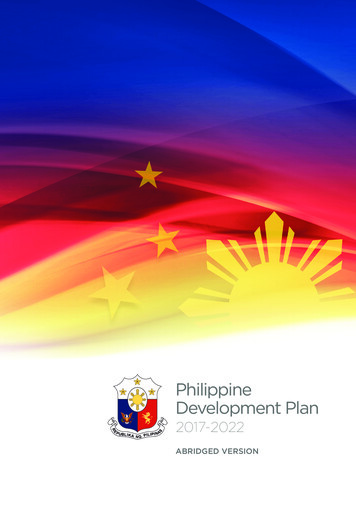
Transcription
PhilippineDevelopment Plan2017-2022ABRIDGED VERSION
PhilippineDevelopment Plan2017-2022ABRIDGED VERSION
2017 by the National Economic and Development AuthorityAll rights reserved. Any part of this publication may be used and reproduced,provided proper acknowledgement is made.Philippine Development Plan 2017-2022Abridged VersionPublished by:National Economic and Development Authority12 St. Josemaria Escriva Drive, Ortigas Center, Pasig City 1605 PhilippinesTel: ( 632) 631 0945 to 56Email: ed in the Philippines
TABLE OF CONTENTSPart 1Part 2Part 3Part 4Part 5INTRODUCTION7The Long View7Global and Regional Trends and Prospects8Overlay of Economic Growth, Demographic Trends, andPhysical Characteristics10Philippine Development Plan 2017-2022 Overall Framework11ENHANCING THE SOCIAL FABRIC (“MALASAKIT”)14Ensuring People-Centered, Clean, and EfficientGovernance14Pursuing Swift and Fair Administration of Justice16Promoting Philippine Culture and Values17INEQUALITY-REDUCING TRANSFORMATION(“PAGBABAGO”)19Expanding Economic Opportunities in Agriculture, Forestry,and Fisheries19Expanding Economic Opportunities in Industry and Servicesthrough Trabaho at Negosyo21Accelerating Human Capital Development23Reducing Vulnerability of Individuals and Families26Building Safe and Secure Communities28INCREASING GROWTH POTENTIAL (“PATULOY NA PAGUNLAD”)29Reaching for the Demographic Dividend29Vigorously Advancing Science, Technology, and Innovation31ENABLING AND SUPPORTIVE ECONOMICENVIRONMENT33Ensuring Sound Macroeconomic Policy33Leveling the Playing Field through a National CompetitionPolicy35
Part 6Part 7FOUNDATIONS FOR SUSTAINABLE DEVELOPMENT37Attaining Just and Lasting Peace37Ensuring Security, Public Order, and Safety38Accelerating Infrastructure Development40Ensuring Ecological Integrity, Clean and Healthy Environment42FROM PLAN TO ACTION45Plan Implementation and Monitoring45ANNEXES47Annex 1: Executive Order No. 0548Approving and Adopting the Twenty-Five-Year LongTerm Vision Entitled AmBisyon Natin 2040 As Guide forDevelopment PlanningAnnex 2: Executive Order No. 2751Directing All Government Agencies and Instrumentalities,Including Local Government Units, to Implement thePhilippine Development Plan and Public Investment Programfor the Period 2017-2022ACKNOWLEDGEMENTS54
1INTRODUCTIONThe Long ViewFilipinos wish to enjoy a “matatag, maginhawa, at panatag na buhay.” This collectivelong-term vision was revealed in a series of focus group discussions and an extensivenationwide survey that asked about the aspirations of Filipinos by 2040.Filipinos want to spend time with family, friends, and their community.They want to enjoy a comfortable lifestyle, including having a decent house withsecure long-term tenure, convenient transport, and being able to travel for vacation.They want to feel secure about the future, wherever they are and wherever they wantto go. They want to live long and healthy and are looking forward to enjoying theirretirement.Such is the AmBisyon Natin 2040 – it is our collective ambition. At the same time,we want it to be the Vision for the country, for which government will formulatepolicies and implement programs and projects to enable all Filipinos to attain thisAmBisyon.On October 11, 2016, President Rodrigo R. Duterte signed Executive Order No. 5, s.2016 approving and adopting the 25-year long-term vision entitled AmBisyon Natin2040 as a guide for development planning (Refer to Annex 1 for the EO). It also laiddown four areas for strategic policies, programs, and projects over the next 25 yearsthat will help realize the AmBisyon Natin 2040. These areas are:a)b)c)d)Building a prosperous, predominantly middle-class society where no oneis poor;Promoting a long and healthy life;Becoming smarter and more innovative; andBuilding a high-trust society. Part 1 Introduction 7
Global and Regional Trendsand ProspectsVarious inter-related international trends projected over the medium term wereconsidered for the Philippine Development Plan (PDP) 2017-2022.Economic TrendsGlobal economic growth is assumed to remain sluggish without an immediateprospect of renewed vigor. The outlook is clouded by uncertainty on the policystance of the United States’ (US).The slowdown in emerging markets, including China, is expected to continue.However, the ASEAN-5 is expected to recover from this slowdown, with an averagegrowth of 5.4 percent in 2017-2022.Global trade is expected to improve slightly, growing by 3.9 percent annually overthe period 2017-2022. The rise of global production networks and buying chains,among other trends, will further drive integration.Over the medium term, global foreign direct investment flows are projected tosurpass US 1.8 trillion in 2018, reflecting an increase in global growth.Monetary policy in the US will likely move towards normalization, while those inthe European Union and Japan will be accommodative to support the recovery oftheir economies.Political TrendsThe political landscape will continue to be affected by the backlash resulting fromthe global financial crisis (GFC). Already, the GFC has given rise to populist andprotectionist regimes, like the United Kingdom’s “Brexit” referendum results andthe US election results.The Middle East will probably continue to be a region of instability, while thePhilippine claim on the West Philippine Sea is likely to remain unresolved. 8 Abridged Philippine Development Plan 2017-2022
Social and Demographic TrendsThe number of senior citizens in the world is projected to grow to 1.4 billion by2030, accounting for more than 25 percent of the populations in Europe andNorthern America, 20 percent in Oceania, 17 percent in Asia and Latin America,and 6 percent in Africa. The Philippines will remain relatively young for some time.Inequality may persist in some nations but is likely to decline as many low- andmiddle-income countries grow faster than rich ones.Innovation is predicted to originate in middle-income economies with strongresearch and development base, although there is a shift towards private fundingfrom public spending.Promising new technologies such as big data analytics, the internet of things,nanomaterials, and even blockchain technology may potentially disrupt and changethe way things are done.Environmental TrendsThere is a wide consensus among professionals about gradually rising temperaturesand climate volatility. According to the Intergovernmental Panel on Climate Change,average global temperature increased by 0.85oC between 1880 and 2002, resultingin significant yield reductions on major crops such as wheat and maize. The world’soceans also continue to warm and polar ice caps continue to melt. Average sea levelsare predicted at 24-30 cm by 2065.The Paris Agreement of 2015 seeks to address climate change although potentialchanges in US policy could undermine implementation. Nevertheless, the localimpact of climate change is driving stakeholders to push for sustainable development. Part 1 Introduction 9
Overlay of Economic Growth,Demographic Trends, and PhysicalCharacteristicsEconomic and Demographic TrendsTotal population in the Philippines has increased to around 101 million as of 2015.By 2020, the population is expected to grow to around 110 million. This amounts toan average annual population growth rate of 1.6 percent from 2015.CALABARZON followed by NCR and Central Luzon have the largest populationsand are predicted to remain so by 2022 and even beyond. The Philippines has 33highly-urbanized cities, with NCR, Metro Cebu, Metro Davao, and Metro Cagayande Oro having the largest populations.Regions with higher gross regional domestic product also have higher populations.CALABARZON, NCR, and Central Luzon account for 62.3 percent of GDP, whileARMM (0.7%), Caraga (1.3%), and MIMAROPA (1.6%) are the lowest contributors.The National Spatial StrategyThe National Spatial Strategy (NSS) will guide public investments and catalyzeprivate investments to maximize agglomeration efficiencies, enhance connectivity,and build up resilience against natural hazards.Agglomeration. The NSS seeks to build on the efficiencies and maximize thebenefits of scale and agglomeration economies (i.e. firms and institutions locatingcloser together). The NSS considered the trends and projections in population andeconomic growth across regions, sub-regions, and cities. Thereafter, metropolitan,regional, and even sub-regional centers have been identified. In general, thesecenters are meant to be engines of growth and hubs for development of surroundingareas.Connectivity. The NSS also seeks to improve linkages among settlements and thecenters in order to equalize opportunities and address socioeconomic inequities.Resilience. Major centers and settlements need to be more resilient against naturalcalamities. There should be multiple routes to and from these major centers and 10 Abridged Philippine Development Plan 2017-2022
settlements; infrastructure and mode of transport in these alternative routes will beguided by geohazards maps. The intent is to prevent the loss of lives and property,and minimize disruptions in economic activity even with the onslaught of naturalcalamities.Philippine Development Plan 2017-2022Overall FrameworkWe are building a future where every Filipino enjoys a matatag, maginhawa, atpanatag na buhay. Just like any building construction, we begin by laying down astrong foundation for more inclusive growth, a high-trust and resilient society, anda globally-competitive knowledge economy. The impact will be manifested in thefollowing outcomes: The Philippines will be an upper middle-income country by 2022.Growth will be more inclusive as manifested by a lower poverty incidencein rural areas – from 30 percent in 2015 to 20 percent in 2022.The Philippines will have a high level of human development by 2022.The unemployment rate will decline from 5.5 percent to 3-5 percent in2022.There will be greater trust in government and in society.Individuals and communities will be more resilient.Filipinos will have greater drive for innovation.These foundational outcomes should be able to support the succeeding mediumterm plans, all the way to 2040 and beyond.Strategic OutcomesA matatag, maginhawa, at panatag na buhay by 2040 will be achieved if we areable to lay down the foundation for inclusive growth, a high-trust and resilientsociety, and a globally-competitive knowledge economy by 2022. This goal will besupported by three pillars - Malasakit, Pagbabago, and Patuloy na Pag-unlad - whichare further supported by strategic policies and macroeconomic fundamentals, andbuilt on a solid bedrock of safety, peace and security, infrastructure, and a healthyenvironment. Part 1 Introduction 11
The major strategic outcomes are the following:Pillar 1: Enhancing the social fabric (Malasakit): There will be greater trust inpublic institutions and across all of society. Government will be people-centered,clean, and efficient. Administration of justice will be swift and fair. There will begreater awareness about and respect for the diversity of our cultures.Pillar 2: Inequality-reducing transformation (Pagbabago): There will be greatereconomic opportunities, coming from the domestic market and the rest of theworld. Access to these opportunities will be made easier. Special attention will begiven to the disadvantaged subsectors and people groups.Pillar 3: Increasing growth potential (Patuloy na Pag-unlad): Many more willadopt modern technology, especially for production. Innovation will be furtherencouraged, especially in keeping with the harmonized research and developmentagenda. And in order to accelerate economic growth even more in the succeedingPlan periods, interventions to manage population growth will be implemented andinvestments for human capital development will be increased.Enabling and supportive economic environment: There will be macroeconomicstability, supported by strategic trade and fiscal policies. A strong and crediblecompetition policy will level the playing field and encourage more investments. 12 Abridged Philippine Development Plan 2017-2022
Bedrock: There will be significant progress in the pursuit of just and lasting peace,security, public order, and safety. Construction of strategic infrastructure thatpromotes growth, equity, and regional development will be accelerated. At thesame time, there will be stronger institutions and more effective protocols to ensureecological integrity, clean and healthy environment.Structure of the PDP DocumentThe PDP document is organized into seven parts following the PDP 2017-2022Overall Strategic Framework. The full document can be accessed online at http://pdp.neda.gov.ph.Part 1 provides the overall context for the Plan. Part 2 is about enhancing the socialfabric (Malasakit) to build the foundations for a high-trust society. Part 3 stressesthe importance of reducing inequalities in economic development opportunities(Pagbabago). Part 4 focuses on increasing growth potential (Patuloy na Pagunlad). Part 5 calls for a supportive economic environment that will enable theeconomy to sustain growth, and Part 6 is about foundations for inclusive andsustainable development. Finally, Part 7 describes the institutional arrangementsfor implementation and monitoring — making sure that what is planned isimplemented and that timely adjustments are done.Each chapter of the PDP enumerates the target outcomes, together with measurableindicators and levels desired. These are elaborated further in the Results Matrices,which can be accessed at smatrices-2. Strategies to attain the target outcomes are supported by publicinvestments, as contained in the Public InvestmentProgram 2017-2022 (www.neda.gov.ph/publicinvestment-programs).The PDP also contains a set of reforms requiringlegislation. A section on Legislative Agenda is addedto each chapter to be submitted to the LegislativeExecutive Development Advisory Council forconsideration.In June 2017, the President issued EO 27 directing“all departments, offices, and instrumentalitiesof the national government” to undertake effortsleading to the full implementation of the PDP 20172022 (Refer to Annex 2 for full text). Part 1 Introduction 13
2ENHANCING THE SOCIALFABRIC (“MALASAKIT”)A basic requirement for inclusive development is that our peoples are proud of beingFilipino and that they fully trust their government. Hence, it will need Malasakit atboth ends – from government and from the citizens.By 2022, there will be greater trust between the people and government. At the sametime, key reforms in the justice system will be done to reduce delays and cost tothose who seek justice at all levels (community/barangay, police, fiscal/prosecution,and the courts).Cultural awareness and valuing our diversity will be promoted as a first step toultimately regain our spirit of nationalism and pride.Ensuring People-Centered, Clean, andEfficient GovernancePublic perception of the Philippine government willcontinuously improve as it works to become cleaner,more efficient, effective, and people-centered.By 2022, the country will improve its rankings inglobal governance indices such as the WorldwideGovernance Indicators (WGI)1, CorruptionPerceptions Index (CPI)2, Global CompetitivenessIndex (GCI)3, and Open Budget Index (OBI)4.1 A research dataset summarizing the views on the quality of governance provided by a large number of enterprise, citizen, and expert surveyrespondents in industrial and developing countries. These data are gathered from a number of survey institutes, think tanks, non-governmentalorganizations, international organizations, and private sector firms.2 Measures the perceived level of public sector corruption in 178 countries and territories based on 13 expert and business surveys. The scoreranges from 0-100, where 0 means that a country is perceived as highly corrupt and a 100 means that a country is perceived as very clean.(Transparency International, 1995).3 The Global Competitiveness Report analyzes competitiveness along 12 pillars: institutions, infrastructure, macroeconomic environment,health and primary education, higher education and training, goods market efficiency, labor market efficiency, financial market development,technological readiness, market size, business sophistication, and innovation.4 The Open Budget Survey uses 109 questions to measure budget transparency, specifically to assess whether the central government makeskey budget documents available to the public in a timely manner and whether the data contained in these documents are comprehensive anduseful. 14 Abridged Philippine Development Plan 2017-2022
StrategiesThe PDP 2017-2022 includes strategies to reduce corruption, achieve seamlessservice delivery, enhance administrative governance, strengthen the civil service,and fully engage and empower citizens. Following are the specific strategies:To reduce corruption Promote public awareness of anticorruption drives.Implement prevention measures.Strengthen deterrence mechanisms.To achieve seamless service delivery Adopt a whole-of-government approach in delivery of key services.Implement regulatory reforms.Improve productivity of the public sector.To enhance administrative governance Right-size the bureaucracy.Strengthen results-based performance management, public financialmanagement, and accountability.To fully engage and empower citizenry Promote participatory governance.Ensure public access to information.Institutionalize response and feedback mechanisms.Implement electoral reforms.To strengthen civil service Promote shared public service values.Improve human resource management systems and streamline processes.Develop and invest in human resource. Part 2 Enhancing the Social Fabric (“Malasakit”) 15
Pursuing Fair and Swift Administrationof JusticeBy 2022, the country’s civil, criminal, commercial,and administrative justice systems will be enhanced.Significant reforms will be undertaken to ensure fairand swift administration of justice. Consequently, thecountry’s ranking in the World Governance Indicator(WGI) rule of law will improve to be in the upperhalf; the World Justice Project (WJP) fundamentalrights and criminal justice indicator to the upper25 percentile; and WJP civil justice indicator to theupper 20 percentile.StrategiesEnhancing systems and rationalizing interdependence among justice sectorinstitutions or actors are essential developmental approaches to provide the timelydelivery of justice. There will be harmonized efforts and seamless coordinationamong the different actors involved in civil, criminal, commercial, and administrativejustice. Strategies to implement these are as follows:To enhance civil, criminal, commercial, and administrative justice systems Institutionalize the Justice Sector Coordinating Council.Strengthen economic justice.Deliver justice real-time.To improve sector efficiency and accountability Deliver fair and equal justice.Enhance accountability through an engaged citizenry.Enhance sector efficiency.16 Abridged Philippine Development Plan 2017-2022
Promoting Philippine Culture and ValuesBy 2022, Filipinos will have greater awareness of ourdiverse culture and values. There will be significantprogress towards inculcating values for the commongood, cultivating creativity, and strengthening culturesensitive governance and development.StrategiesThe priority areas of the cultural agenda are: (a) safeguarding and enshrining ourcultural heritage; (b) achieving equity and inclusion in access to cultural resourcesand services; and (c) sustaining and enhancing cultural assets to foster creativityand innovation for socioeconomic growth.To value our diverse cultures Develop, produce, disseminate, and liberalize access to information onFilipino culture.Institutionalize and intensify heritage conservation plans and programs.Establish Knowledge Development Centers and Schools of LivingTraditions for building capacities of Filipinos.Expand inclusive cultural structures as civic spaces for dialogue andcultural exchange.To inculcate values for the common good Determine a set of core values that foster the common good.Utilize various channels of values inculcation to reach all communitymembers.Increase government efforts for promotion of values that foster thecommon good.Mainstream cultural education in the basic, technical, vocational, andhigher education systems.To advance “pagkamalikhain” or value of creative excellence Boost the development of Filipino creativity as tool for social cohesion andimpetus for culture-based industry and creative economy (See also PDPChapter 14).Build public appreciation of Filipino creativity (See also PDP Chapter 9). Part 2 Enhancing the Social Fabric (“Malasakit”) 17
To strengthen culture-sensitive governance and development Pursue institutional reforms for cultural development.Develop cultural assets across the country.Establish historic and cultural complexes nationwide as hubs for culturaleducation, entertainment, and tourism.Strengthen the protection of the rights of vulnerable sectors of society(indigenous peoples, women, youth & children and persons with disability)to access cultural resources and to live a life free from discrimination andfear (See also PDP Chapter 5).18 Abridged Philippine Development Plan 2017-2022
)The Pagbabago pillar seeks to make it easier for the marginalized subsectors andpeople groups to participate in economic progress.Expanding Economic Opportunitiesin Agriculture, Forestry, and FisheriesBy 2022, there will be more economic opportunitiesfor all. Lagging economic sectors like farmers andfisherfolk will be given priority and will have easieraccess to economic opportunities. Doing so willenable them to partake in economic activities andgrowth. Specific targets for this sector are provided inTable 8.2 of the full PDP 2017-2022 document.StrategiesThe government will ensure the sustainability of its efforts to improve the productivityof the agriculture, forestry, and fisheries (AFF) sector and to continuously build thecapacity of AFF stakeholders. To expand the access of farmers and fisherfolk toeconomic opportunities, the government will implement the following strategies:To improve AFF productivity within the ecological limit Develop an integrated color-coded agricultural map to identify thecomparative advantage of specific areas.Accelerate construction of disaster- and climate-resilient small-scaleirrigation systems and improve existing ones.Facilitate the use of appropriate farm and fishery machinery and equipment.Strengthen the extension system (the process of linking AFF stakeholdersto extension workers) that can provide the stakeholders with technicalassistance and capacity building activities.Pursue an ecosystems approach to fisheries management. Part 3 Inequality-Reducing Transformation (“Pagbabago”) 19
To increase AFF-based enterprises Diversify into commodities with high value-adding and market potential.Expand AFF-based enterprises through new and innovative productionand marketing schemes.Strengthen community-based enterprises in upland areas.Increasing the access to economic opportunities requires facilitating the smallfarmers’ and fisherfolk’s access to production markets, new technology, andfinancing services. The following strategies will be carried out by the government:To increase the stakeholders’ access to value chains Physically link production areas to markets through road and rail-basedtransport, inter-island water transport and logistics system.Organize small farmers and fisherfolk into formal groups and farms intoclusters to create economies of scale (the lessening of costs due to anincreased level of production).Provide capacity building for small farmers and fisherfolk on value-addingactivities.Provide non-farm livelihood options, especially to seasonal farm andfishery workers, whose incomes are irregular and who are vulnerable toshocks.To increase farmers’ and fisherfolk’s access to innovative financing Increase the number of small farmers and fisherfolk that are provided withagricultural insurance.Provide small farmers and fisherfolk easy access to affordable formal credit.To increase AFF stakeholders’ access to technology Raise investments in research and development (R&D) for production andpost-harvest technologies.Enhance capacity of small farmers and fisherfolk to use better and newtechnologies (See also in PDP Chapter 14).To increase and protect the access of small famers and fisherfolk to landand water resources Ensure and protect land tenure security of agrarian reform beneficiaries(ARBs) by completing the land acquisition and distribution andimmediately install ARBs in awarded lands.Fast track the resolution of agrarian-related cases.Revisit Section 20 of the Local Government Code, which authorizes localgovernment units to reclassify agricultural lands for other uses.Complete the delineation of municipal waters.Complement strategic efforts with environmental and governancestrategies.20 Abridged Philippine Development Plan 2017-2022
Expanding Economic Opportunitiesin Industry and Services throughTrabaho at NegosyoBy 2022, the Industry and Services (I&S) sector willbe globally competitive. Economic ties with othercountries will be strengthened, leading to free tradeagreements and other cooperative agreements thatcan be maximized by local stakeholders. Citizens willbe given access to economic opportunities throughjob creation and encouraging entrepreneurship in thecountry. Targets set for the I&S can be found in Table9.1 of the full PDP 2017-2022 document.StrategiesExpanding economic opportunities in the I&S entails creating Trabaho and Negosyo,which will provide income to people and ensure availability of good quality productsand services in the country at competitive prices.To increase local and foreign direct investments Strengthen value and supply linkages through:-- Implementing the comprehensive national industrial strategy;-- Adopting a holistic market-driven perspective (See also PDP Chapter8).-- Improving backbone services such as financial, telecommunications,distribution, transport, and logistics services;-- Enhancing business services such as legal and accounting, researchand development, and packaging; and-- Implementing the new medium-term National Tourism DevelopmentPlan.Remove restrictions, provide incentives, and promote job-creatinginvestments through:-- Amending restrictive economic provisions in the Constitution;-- Modernizing the incentive system to remove nationality and exportbiases;-- Implementing aggressive investment promotion programs;-- Addressing cross-cutting issues (See also PDP Chapter 19); and-- Supporting the development of the services subsectors outside value Part 3 Inequality-Reducing Transformation (“Pagbabago”) 21
and supply chains (See also PDP Chapter 19).Accelerate the implementation of infrastructure programs and projects(See also PDP Chapter 19).To increase competitiveness, innovativeness, and resilience of I&S Develop high value-added, competitive, and sustainable sectors through:-- Improving the competitiveness of the I&S;-- Adopting a cluster-based industrial approach;-- Providing incentives for green manufacturing;-- Fully implementing the Green Jobs Act (See also PDP Chapter 8); and-- Focusing attention on boosting services exports.Improve the business climate to encourage investments through:-- Implementing structural reforms to create more open, wellfunctioning, transparent, and competitive markets (See also PDPChapters 5, 16, and 19) and-- Simplifying the rules and regulations on business registration andlicensing, entry and exit, paying taxes, and access to finance.Improve access to technology and innovation through:-- Establishing the National Quality Infrastructure;-- Establishing an Inclusive Innovation Center (See also PDP Chapter14); and-- Encouraging innovation and adoption of new technologies (See alsoPDP Chapter 14).Enhance labor capacities through:-- Investing in human capital development (See also PDP Chapter 11);and-- Strengthening industry-academe linkages (See also PDP Chapter 11).To improve the market access Maximize opportunities that expand access to existing and new marketspresented by the ASEAN Economic Community and other preferentialtrading agreements (See also PDP Chapter 15).To ensure consumer access to safe and quality goods and services Heighten consumer vigilance on product safety, value for money, andaccess to quality goods and services.Enforce regulations and standards to protect, promote, and empowerconsumers against unfair trade practices.Build stronger linkages and partnerships with the private sector andprofessional associations to strengthen consumer redress mechanisms.Harmonize domestic and international policy frameworks on consumerprotection.22 Abridged Philippine Development Plan 2017-2022
Increasing access to economic opportunities entails helping out entrepreneurs,especially the micro, small, medium enterprises (MSMEs), cooperatives, andoverseas Filipinos (OFs). A conducive environment for Negosyo will be createdthrough the following:To improve access to production networks Support linkages between MSMEs and large corporations to facilitateincreased participation of the former in global value chains.Develop more inclusive business models and social enterprises.Establish feasible domestic economic zones for MSMEs.To improve the stakeholders’ access to finance Streamline and simplify loan processes for MSMEs, cooperatives, and OFs.Provide financial literacy training for MSMEs, cooperatives, and OFs andtheir families.Assess MSME-related laws.To improve the stakeholders’ productivity, efficiency, a
the global financial crisis (GFC). Already, the GFC has given rise to populist and protectionist regimes, like the United Kingdom's "Brexit" referendum results and the US election results. The Middle East will probably continue to be a region of instability, while the Philippine claim on the West Philippine Sea is likely to remain unresolved.
